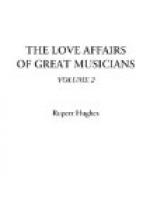Wagner’s first libretto, “The Wedding” (Die Hochzeit), horrified his sister so, that he destroyed it at her request. His third, “Das Liebesverbot,” was based on Shakespeare’s “Measure for Measure,” with the slight distinction that where Shakespeare’s play is a preachment for virtue, Wagner himself said that his libretto was “the bold glorification of unchecked sensuality.” Years afterward, admirers of his put the work in rehearsal, but gave it up as too licentious. This apostle of unrestrained amours found himself most prosaically married and involved in the most commonplace struggle for daily bread, when he was only twenty-three.
In 1833, at the age of twenty, Wagner had taken up music professionally, and got a position as chorus-master. In 1834, he became musical director at the theatre in Magdeburg. The company, made up principally of young enthusiasts, who worked day and night, rehearsed Wagner’s opera, “Das Liebesverbot.” The first night there was a crowded house, but the troupe went all to pieces. The next night was to be Wagner’s benefit. Fifteen minutes before the curtain rose, he found the audience consisted of his landlady, her husband, and one Polish Jew. A free fight broke out behind the scenes; the prima donna’s husband smote the second tenor, her lover, and every one joined in; even that small audience was dismissed. In this company die erste Liebhaberin was Wilhelmine Planer, one of twelve children of a poor spindle-maker. When the Magdeburg company went to pieces, Wagner went to Leipzig and offered the opera to a manager, whose daughter was the chief singer. The manager said that he could not permit his daughter to appear in such a work. Eventually, Wagner drifted to Koenigsberg, where he became director of the theatre, and where Wilhelmine had found a position. The two had become engaged in Magdeburg, and they were married at Koenigsberg, on November 24, 1836.
The theatre soon followed the example of that at Magdeburg and went into bankruptcy. During the honeymoon year, Wagner had composed only one work, an overture, based on “Rule Britannia.” At that time “The Old Oaken Bucket” had not been written. He then drifted to Riga, where he became music-director and his wife a singer. Now his relentless ambition seized him and he determined to consecrate the rest of his life to glory. His wife found herself consecrated to poverty and the fanatic ideals of a husband, to whom starvation was only a detail in the scheme of his life,—a scheme and a life for which she had neither inclination nor understanding.
Wilhelmine, or Minna, as she was called, is described as pretty by some and as of a “pleasing appearance,” by others. The painter Pecht called her very pretty, but blamed her for a sober, unimaginative soul. Richard Pohl calls her a prosaic domestic woman, who never understood her husband, and who might have been an impediment to his far-reaching ideas, if Richard Wagner could have been impeded in his career by anything. Wagner himself seems to have been genuinely fond of her, though never, perhaps, deeply in love with her. He called her an “excellent housewife,” who lovingly and faithfully shared much sorrow and little joy with him.




